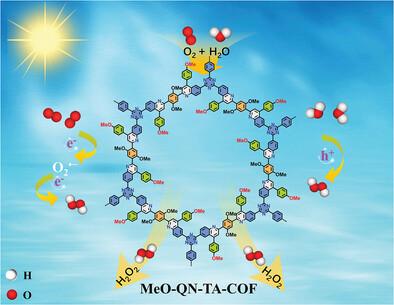Linkage Microenvironment Modulation in Triazine-Based Covalent Organic Frameworks for Enhanced Photocatalytic Hydrogen Peroxide Production
IF 13
2区 材料科学
Q1 CHEMISTRY, MULTIDISCIPLINARY
引用次数: 0
Abstract
Covalent organic frameworks (COFs), known for the precise tunability of molecular structures, hold significant promise for photocatalytic hydrogen peroxide (H2O2) production. Herein, by systematically altering the quinoline (QN) linkages in triazine (TA)-based COFs via the multi-component reactions, six R-QN-TA-COFs are synthesized with identical skeletons but different substituents. The fine-tuning of the optoelectronic properties and local microenvironment of COFs is allowed, thereby optimizing charge separation and improving interactions with dissolved oxygen. Consequently, MeO-QN-TA-COF is customized to achieve an impressive rate of H2O2 production up to 7384 µmol g⁻1 h⁻1 under an air atmosphere in water without any sacrificial agents, surpassing most of the reported COF photocatalysts. Its high stability is demonstrated through five consecutive recycling experiments and the characterization of the recovered COF. The reaction mechanism for the H2O2 production is further investigated using a suite of quenching experiments, in situ spectroscopic analysis, and theoretical calculations. The enhanced photocatalytic H2O2 production over MeO-QN-TA-COF is through 2e⁻ oxygen reduction reaction and water oxidation reaction pathways. Overall, the crucial role of linkage microenvironment modulation in the design of COFs for solar-driven effective photocatalytic H2O2 production.

求助全文
约1分钟内获得全文
求助全文
来源期刊

Small
工程技术-材料科学:综合
CiteScore
17.70
自引率
3.80%
发文量
1830
审稿时长
2.1 months
期刊介绍:
Small serves as an exceptional platform for both experimental and theoretical studies in fundamental and applied interdisciplinary research at the nano- and microscale. The journal offers a compelling mix of peer-reviewed Research Articles, Reviews, Perspectives, and Comments.
With a remarkable 2022 Journal Impact Factor of 13.3 (Journal Citation Reports from Clarivate Analytics, 2023), Small remains among the top multidisciplinary journals, covering a wide range of topics at the interface of materials science, chemistry, physics, engineering, medicine, and biology.
Small's readership includes biochemists, biologists, biomedical scientists, chemists, engineers, information technologists, materials scientists, physicists, and theoreticians alike.
 求助内容:
求助内容: 应助结果提醒方式:
应助结果提醒方式:


